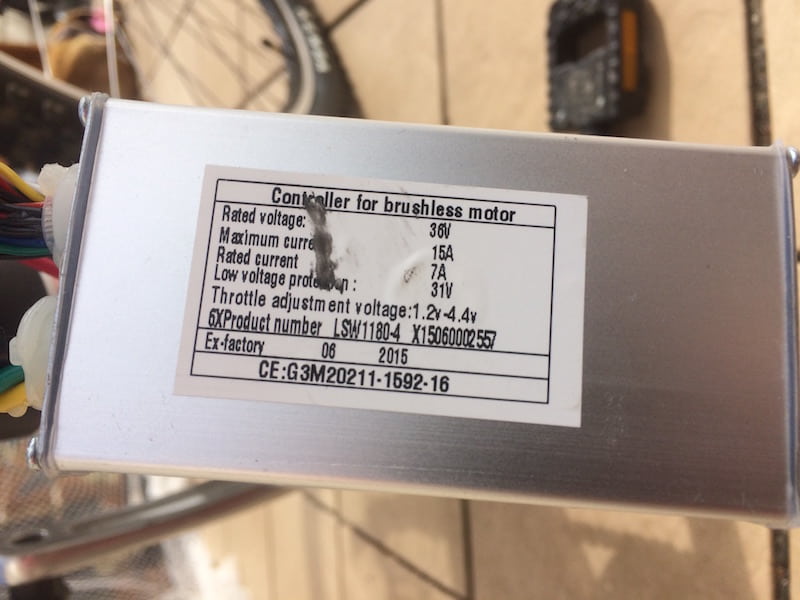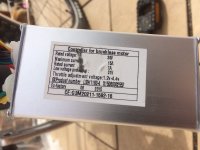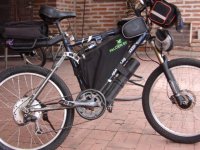I recently picked up a second hand Apache 26:
http://dillengerelectricbikes.com.au/electric-bikes/folding-electric-bikes/apache-26-folding-electric-bike-by-dillenger.html
This is a nicely built bike, but the road legal configuration just doesnt have enough power to drag me up hills, on a decent hill the motor struggles big time and I find its actually more effort to pedal it than my mtn bike. I'm a 100kg bloke, and I live in a hilly place.
I actually dont care that much about top speed, but its got to get me up the hills.
I emailed Dillinger to get some advice on getting some more performance out of it, and they basically said forget it.
So, I'm thinking about putting a new hub motor and controller on it, and ideally keeping the existing battery (to avoid shelling out heaps more cash).
FWIW, the existing hub motor is a bafang 250W, and this is the controller:

And it has a C965 display on it.
From what I read, a Bafang 36v BPM 500W should provide twice as much grunt, and if I choose the 201RPM high torque option, that will maximise the hill climbing, at the expense of top speed. And hopefully it should be a simple swap out of the existing bafang hub.
So I'm looking at:
https://bmsbattery.com/ebike-kit/350-bafang-bpm2-36v500w-rear-driving-e-bike-hub-motor-ebike-kit.html
at $139
and
https://bmsbattery.com/ebike-kit/551-s12p-750w-torque-simulation-square-wave-controller-ebike-kit.html
at $29
or this one? : https://bmsbattery.com/ebike-kit/805-s-ku63-250w15a-6mosfets-controller-ebike-kit.html
They basically have this as a kit, with the wheel already spoked:
https://bmsbattery.com/ebike-kit/347-bafang-bpm2-36v500w-rear-driving-bike-conversion-kit-ebike-kit.html
Couple of questions if anyone can give me advice:
1. Do you think this will solve the hill climbing problem
2. Is driving this stuff off the existing 36V batter realistic, or should I shell out the bucks to repack the battery to 48V?
3. Do you think I will be able to fit this hub controller combo to the Apache?
4. What's the difference between the hub linked above, and the "CST" option which costs a fair bit more, eg https://bmsbattery.com/motor/505-bafang-36v350w-cst-rear-driving-hub-motor-motor.html
5. Any comments on BMSBattery as a supplier, and any better options of where to get a bafang BPM?
Thanks in advance
Jon
http://dillengerelectricbikes.com.au/electric-bikes/folding-electric-bikes/apache-26-folding-electric-bike-by-dillenger.html
This is a nicely built bike, but the road legal configuration just doesnt have enough power to drag me up hills, on a decent hill the motor struggles big time and I find its actually more effort to pedal it than my mtn bike. I'm a 100kg bloke, and I live in a hilly place.
I actually dont care that much about top speed, but its got to get me up the hills.
I emailed Dillinger to get some advice on getting some more performance out of it, and they basically said forget it.
So, I'm thinking about putting a new hub motor and controller on it, and ideally keeping the existing battery (to avoid shelling out heaps more cash).
FWIW, the existing hub motor is a bafang 250W, and this is the controller:
And it has a C965 display on it.
From what I read, a Bafang 36v BPM 500W should provide twice as much grunt, and if I choose the 201RPM high torque option, that will maximise the hill climbing, at the expense of top speed. And hopefully it should be a simple swap out of the existing bafang hub.
So I'm looking at:
https://bmsbattery.com/ebike-kit/350-bafang-bpm2-36v500w-rear-driving-e-bike-hub-motor-ebike-kit.html
at $139
and
https://bmsbattery.com/ebike-kit/551-s12p-750w-torque-simulation-square-wave-controller-ebike-kit.html
at $29
or this one? : https://bmsbattery.com/ebike-kit/805-s-ku63-250w15a-6mosfets-controller-ebike-kit.html
They basically have this as a kit, with the wheel already spoked:
https://bmsbattery.com/ebike-kit/347-bafang-bpm2-36v500w-rear-driving-bike-conversion-kit-ebike-kit.html
Couple of questions if anyone can give me advice:
1. Do you think this will solve the hill climbing problem
2. Is driving this stuff off the existing 36V batter realistic, or should I shell out the bucks to repack the battery to 48V?
3. Do you think I will be able to fit this hub controller combo to the Apache?
4. What's the difference between the hub linked above, and the "CST" option which costs a fair bit more, eg https://bmsbattery.com/motor/505-bafang-36v350w-cst-rear-driving-hub-motor-motor.html
5. Any comments on BMSBattery as a supplier, and any better options of where to get a bafang BPM?
Thanks in advance
Jon




